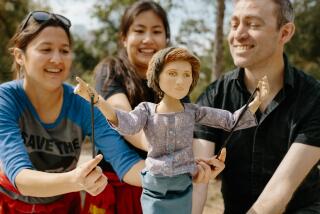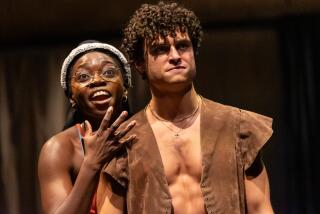GIVE ‘EM A REALLY BIG HAND : Trio Known as Mummenschanz Can Make Even Mime Grab an Audience
- Share via
For two decades, a trio of mimes known as Mummenschanz has been captivating audiences with a unique kind of theater combining mime, masks, movement and puppetry.
Taking its name from the German “mummen,” meaning game or play, and “schanz” meaning chance, the troupe emphasizes whimsy and the most humane kind of satire. Mummenschanz will appear Monday at the Irvine Barclay Theatre in a sold-out performance.
Giant hands may part the curtain at a Mummenschanz performance and wag a finger to welcome the audience. Later, one of the hands may wander through the crowd.
Huge, flexible shapes and tubes will slither around the stage, slowly climbing the evolutionary ladder and raising questions along the way.
Inventive masks will be adorned with balloons, Ping-Pong balls, note pads or rolls of toilet paper.
All of this will evoke humorous or poignant human struggles and foibles.
In one skit, for example, two ends of a carpet shyly court each other. But the romance is doomed. One end abandons the other.
In another skit, a beanbag struggles valiantly to climb onto a box. It is hard to repress encouraging cheers.
A Silly Putty sketch allows the actors to rearrange features of their faces, changing from happiness to anger to sadness with disconcerting and frightening ease. Sometimes, Mummenschanz turns very serious.
Sometimes, too, the costumes are so elaborate and complex that the actors cannot see one another, and must rely on sound cues or timing or even audience reaction to know how where they are.
Founded in 1972 by Andres Bossard, Bernie Schurch and Floriana Frasetto, Mummenschanz grew out of a nightclub act created by Bossard and Schurch after they graduated from the Jacques LeCoq school of mime in Paris.
At first they used dialogue as well as mime in the act, but they quickly gave up talking to explore the possibilities of greater expression in silence and movement. Over time, the group grew so popular that several sub-troupes had to be sent out to fill all the requests for shows.
Bossard died in 1992 at the age of 48, and the Mummenschanz program took on an even more serious turn to reflect the loss. But much of the original whimsy and humor survives and remains the programs’ mainstay.
More to Read
The biggest entertainment stories
Get our big stories about Hollywood, film, television, music, arts, culture and more right in your inbox as soon as they publish.
You may occasionally receive promotional content from the Los Angeles Times.










